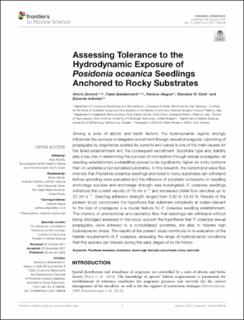| dc.contributor.author | Zenone, Arturo | |
| dc.contributor.author | Badalamenti, Fabio | |
| dc.contributor.author | Alagna, Adriana | |
| dc.contributor.author | Gorb, Stanislav N. | |
| dc.contributor.author | Infantes, Eduardo | |
| dc.date.accessioned | 2022-05-30T10:22:16Z | |
| dc.date.available | 2022-05-30T10:22:16Z | |
| dc.date.created | 2022-01-28T19:26:06Z | |
| dc.date.issued | 2022 | |
| dc.identifier.citation | Frontiers in Marine Science. 2022, 8 . | |
| dc.identifier.issn | 2296-7745 | |
| dc.identifier.uri | https://hdl.handle.net/11250/2996724 | |
| dc.description.abstract | Among a suite of abiotic and biotic factors, the hydrodynamic regime strongly influences the success of seagrass recruitment through sexual propagules. Uprooting of propagules by drag forces exerted by currents and waves is one of the main causes for the failed establishment and the consequent recruitment. Substrate type and stability play a key role in determining the success of colonization through sexual propagules, as seedling establishment probabilities proved to be significantly higher on rocky bottoms than on unstable unconsolidated substrates. In this research, the current and wave flow intensity that Posidonia oceanica seedlings anchored to rocky substrates can withstand before uprooting were evaluated and the influence of substrate complexity on seedling anchorage success and anchorage strength was investigated. P. oceanica seedlings withstood the current velocity of 70 cm s–1 and increased orbital flow velocities up to 25 cm s–1. Seedling adhesion strength ranged from 3.92 to 29.42 N. Results of the present study corroborate the hypothesis that substrate complexity at scales relevant to the size of propagules is a crucial feature for P. oceanica seedling establishment. The intensity of unidirectional and oscillatory flow that seedlings can withstand without being dislodged assessed in this study support the hypothesis that P. oceanica sexual propagules, once adhered to a consolidated substrate, are able to tolerate high hydrodynamic stress. The results of the present study contribute to re-evaluation of the habitat requirements of P. oceanica, assessing the range of hydrodynamic conditions that this species can tolerate during the early stages of its life history. | |
| dc.language.iso | eng | |
| dc.title | Assessing Tolerance to the Hydrodynamic Exposure of Posidonia oceanica Seedlings Anchored to Rocky Substrates | |
| dc.type | Peer reviewed | |
| dc.type | Journal article | |
| dc.description.version | publishedVersion | |
| dc.source.pagenumber | 10 | |
| dc.source.volume | 8 | |
| dc.source.journal | Frontiers in Marine Science | |
| dc.identifier.doi | 10.3389/fmars.2021.788448 | |
| dc.identifier.cristin | 1992927 | |
| cristin.ispublished | true | |
| cristin.fulltext | original | |
| cristin.qualitycode | 1 | |
